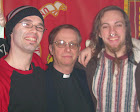Wednesday, July 22, 2009
The Gay Brothers (1894)
Vito Russo, in his book The Celluloid Closet (1976), gave us the first study of gay film. Even today, almost 35 years later, it remains a valuable reference. In it, he claims that the Dickson Experimental Sound Film, which he calls The Gay Brothers, is the first gay film. Yet, when we look closely at the film, and the conditions under which it was produced, it seems less and less likely that it is truly a gay film, and that there are several other period films which have at least as strong a claim on the title.
Russo did not address all aspects of Hollywood film in his book, omitting especially the ancient epic genre, but including provocative stills from a number of them (Ben-Hur, Sign of the Cross, etc.). Looking at The Gay Brothers, I was somewhat uncomfortable with his claims. The more I looked into the film, and studied it, the weaker Russo's claim seemed to become. He examined the film from a modern, rather than contemporary point of view, and read as sexual, opportunistic homosocial actions designed simply to keep the action centred before the camera. This is why the men seem to embrace closely. Their legs are in proximity so that they can pivot easily and quickly if they start to stray from the camera's limited field of vision. I believe that two concerns were in force motivating Russo's claim: 1) that he sincerely wished to find an early gay film - the earlier, the better; and 2) that he allowed his intention to colour his reading of the film.
I also researched The Gay Brothers to see if there was any information which supported Russo's contention. The Ott Brothers, Fred and John, worked for Edison, but their names have never been associated with this film. At this point, there seems no support for the men being brothers, nor is there anything to suggest that they may have been gay. The Gay Brothers name was never used before Russo made his claims in The Celluloid Closet.
The film's history is itself somewhat involved. There is some evidence that it may have been considered for public showing, but none that this ever actually happened. It remains an experiment in image and sound synchronisation. Some critics claim that the experiment was a failure, but a number of Kinetophones were built and shipped before the Kinetoscope craze ended in 1905, and the Kinetophone was reintroduced in 1912. This suggests that the experiment was not a failure, but a success. For many years, only the film portion remained. In 1964, a broken cylinder recording was found marked "Dickson-Violin by W.K.L. Dixon with Kineto". When it was eventually repaired, in 2000, the sound was transferred to digital media, and the sound and image were reunited after an interval of 106 years. Dickson plays Song of the Cabin Boy, from Les Cloches de Corneville, an 1877 operetta by Robert Planquette. The lyrics, which are not used in the film, celebrate life at sea with no women.
Other early Edison films which might have gay content are Sandow, Princess Ali, Dewar's and Old Maid Having Her Picture Taken. Certainly the exposition and appreciation of the male body, which is the primary content of Sandow is of gay interest. This film of Eugen Sandow, perhaps the first professional body builder has as much right to the title of first gay film as the Dickson film. It was made in May, 1894. Filmed a year later than Sandow, Princess Ali seems especially interesting as it appears a young man dances in women's clothing. This is very transgressive, until one realises that Princess Ali worked for the Barnum and Bailey Circus as a bearded lady.
Dewar's, made in 1897 was the first commercial, celebrating Dewar's Scotch Whiskey. The skirt-clad men, however, are not transgressive, merely Scottish. The last film, Old Maid Having Her Picture Taken, starring female impersonator Gilbert Saroney was filmed in 1901(Russo says 1903). Saroney made a career of portraying ill-favoured women, and made seven films as the Old Maid, or about his work portraying her in vaudeville. In 1886, he was best man at the wedding of male impersonator Annie Hindle and Anna Ryan. There seems to be a lot of gay content here.
Subscribe to:
Post Comments (Atom)

No comments:
Post a Comment